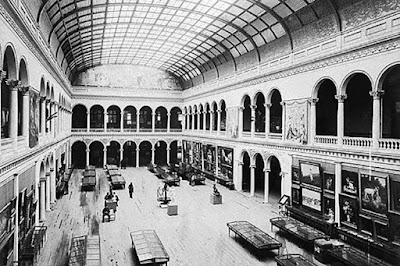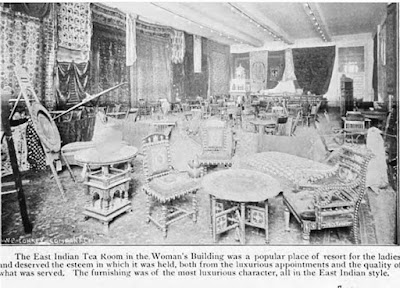Tapestries, banners and paintings were hung in the main
hall of the Women's Building at the World's Columbian Exposition
She noted: "A striking absence of quilt exhibits or individual quilts mentioned in conjunction with the World’s Columbian Exposition." She interviewed quilt historians Xenia Cord and Merikay Waldvogel who emphasized quiltmaking's popularity at the time, particularly crazy quilts, but noted the absence in fair records.
The Women's Building designed by Sophia Hayden
Bertha Honore Palmer (1849-1918)
married a wealthy Chicago merchant and hotel owner
Crickett Harmer considers the attitudes of two aesthetes in charge of the Women's Building: Bertha Honore Palmer and Candace Thurber Wheeler. Bertha Palmer was leader of the "Board of Lady Managers," who planned and conducted the women's exhibits.
Candace Thurber Wheeler (1827-1923)
Candace Wheeler, a leading advocate of arts and crafts design principles with one-time design partner Louis Comfort Tiffany, was in charge of the interior design of the Women's Building and brought her vision to rooms like the library, an Arts & Crafts version of Beaux Arts classicism.
Library ceiling mural by Dora Wheeler Keith, Candace's daughter
Both taste-makers were determined that the displays remain free from the mundane, the everyday crafts fair goers might dismiss. Cricket Harmer quotes Bertha Palmer:
"We want to keep this exhibit very choice. We must keep the standard up to the highest point. No sentimental sympathy for women should cause us to admit second-rate things into this gallery.”
Apparently the Board chose 458 articles of art to display in the Women's Building. A search through the catalog reveals no quilts or coverlets, but many embroidered articles.
Cushion from a Swedish designer using the sunflower,
a favorite Arts & Crafts image.
Design from Vienna's Working Women's Society
Under "spreads" a French piece
Embroidered pillow in Arts & Crafts style that flourished
in the early 20th century
Ignoring crazy quilts, however, was not going to
make them go away.
Tomorrow: Quilts in the state buildings.














I've enjoyed this series so much! In all this wonderful research, I truly wish someone would come across 50 bolts of those fabulous 1890 neons! When your "Ragtime" came out I should have realized how fleeting the popularity would be and scarfed up all I could. Maybe it will make its way around again before my fingers finally fail me. Thanks for these great posts. Looking forward to #7.
ReplyDeleteBarbara,
ReplyDeleteThank you for quoting my earlier research.
Another contributing factor at the time, was the fear of cholera. Sanitation being the root cause. Candace Wheeler assumed all stuffed and layered textiles to be carriers of germs.
Your article makes me so delighted. At the time of doing my research most experts told me I had to be wrong, quilts had to be present at the exhibition.